Company Updates
Halloween’s Ultimate Candy Contenders
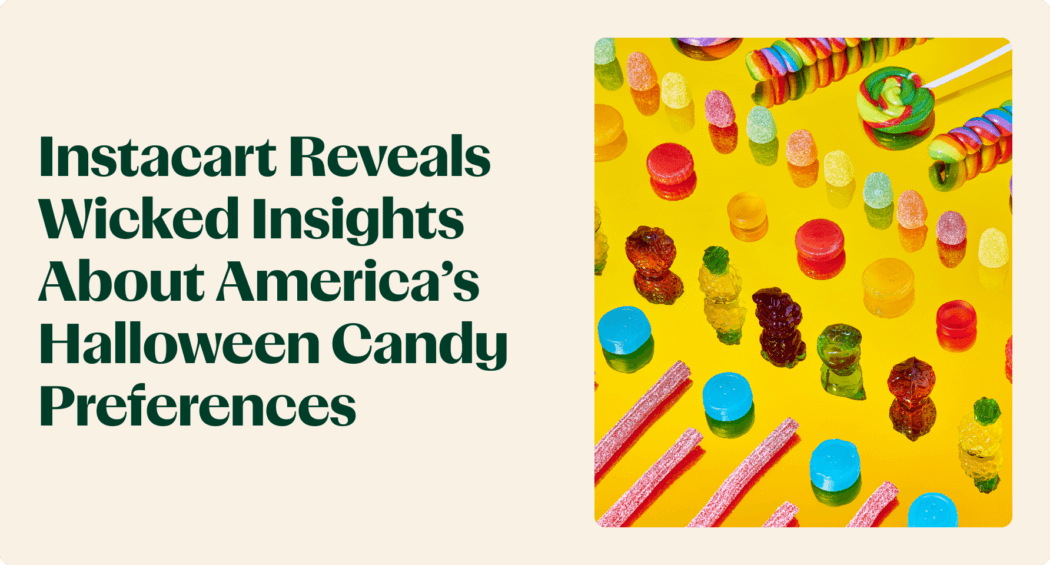
Spooky season is here, which means Halloween planning is already underway, pumpkins are gracing front porches and candy is about to have its biggest moment. Each Halloween, we glean major insights from Instacart’s purchase data to see what Halloween candies people enjoy — or fill trick-or-treaters’ stashes with — and this year, we’re here to deliver sweet new findings of some striking candy rivalries that demonstrate candy preferences throughout the U.S., in addition to other spooktacular insights.
Halloween is a big deal 🎃 — according to a recent Instacart survey of more than 2,000 Americans conducted online by The Harris Poll, 72% of Americans like Halloween and about a quarter of Americans (24%) say Halloween is their favorite holiday, with only a small 7% who noted they dread the bewitching festivity. Further, regardless of whether or not Americans like Halloween, 82% still say they purchase Halloween candy — which is a lot of sugar we’re going to break down for you…
Witch Better Have My Candy 🍬
Starting with the top 10 most popular candies sold from Halloween 2021, here’s what we can expect candy bowls will be filled with again soon:
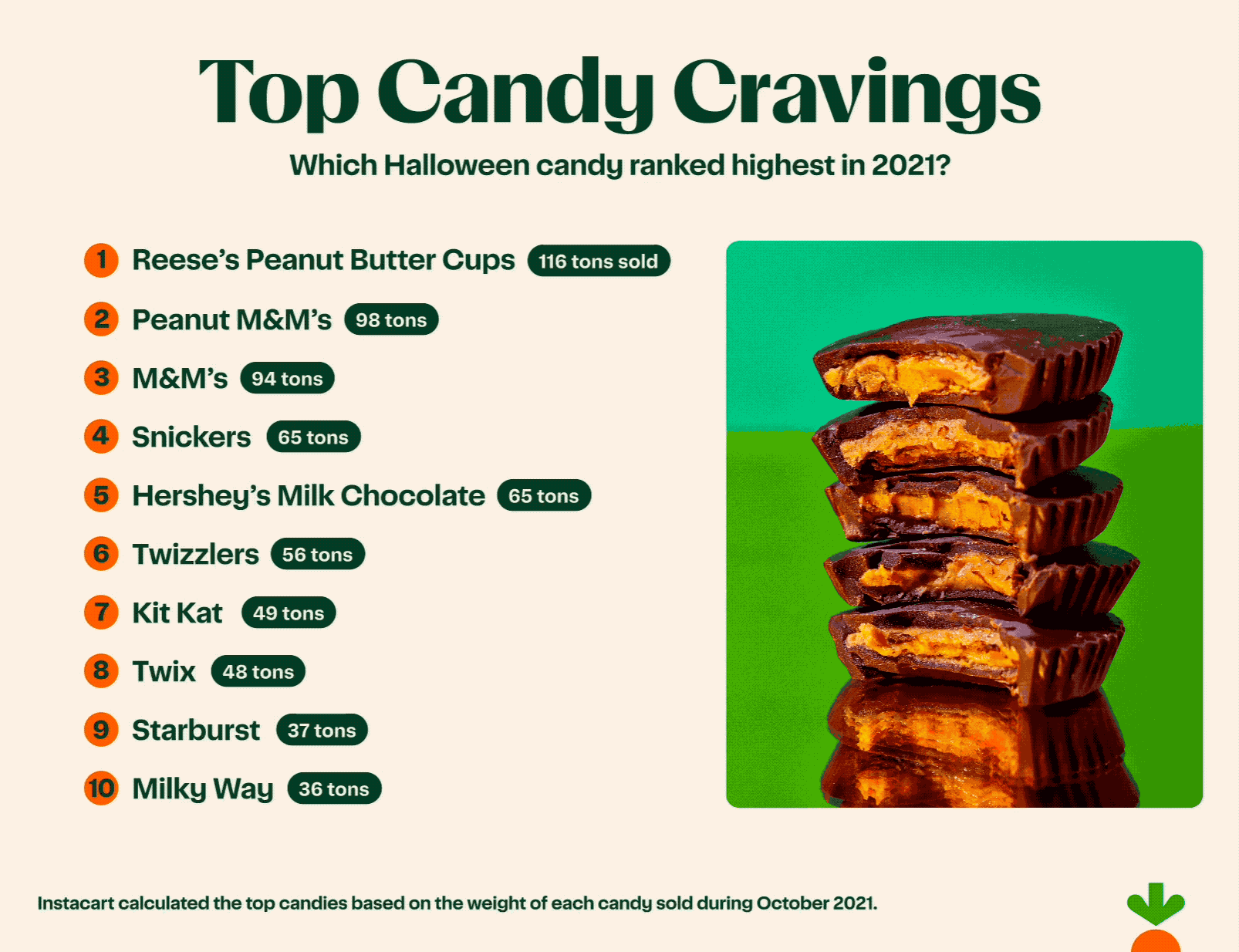
- Give Them Something to Choco ‘Bout. Our survey found that 84% of the people who buy Halloween candy will be picking up chocolate, so it’s no surprise the smooth confection reigns supreme by taking 8 out of the top 10 spots. Reese’s Peanut Butter Cups come in first — because we all know those fresh, seasonal pumpkin-shaped peanut butter cups are hard to Reese-ist — followed by Peanut M&M’s in 2nd, M&M’s in 3rd, Snickers in 4th, Hershey’s Milk Chocolate in 5th, Twix in 8th, and Milky Way in 10th.
- Chew This. Following chocolate, 56% of those who buy Halloween candy will purchase fruity and chewy candy, which explains why Twizzlers fall in 6th followed by Starburst in 9th on the top 10 list.
United States of Candy Contenders 🍫
Peanut M&Ms or Reese’s Peanut Butter Cups? Twizzlers or Red Vines? Sweet Tarts or Smarties? Do you sense a theme, and do you have a preference? Our spellbinding insights illustrate a shift in confectionery preferences across the United States, showing us we’re more likely to favor one type of candy over its close competitor. Laurentia Romaniuk, Instacart’s Trends Expert, explains this phenomenon:
“There are thousands of types of candy, offering a breadth of unique flavors, textures, and levels of sweetness so there’s something for everyone. While every type of candy is loved across the U.S. — from the Halloween classics to newer, innovative treats — we observed different areas of the U.S. will notably gravitate toward specific types of candy. Depending on who we are, where we’re from and what we’re exposed to, we are more likely to prefer one variation of candy over something similar. This doesn’t suggest we only like one type of candy or another, but our purchase data demonstrates people are highly selective when preparing for Halloween night. These strong sugar tendencies may also explain why many kids will trade Halloween candies with their siblings or friends to bolster their selection of personal favorites.”
Starting with the most popular Halloween candy sold in each state, there’s a near-even split in the U.S. with Peanut M&M’s ranking most popular in the West and Reese’s Peanut Butter Cups dominating in the East and in Wyoming. The two exceptions are Hawaii and New Hampshire which chose M&M’s as their favorite Halloween candy.
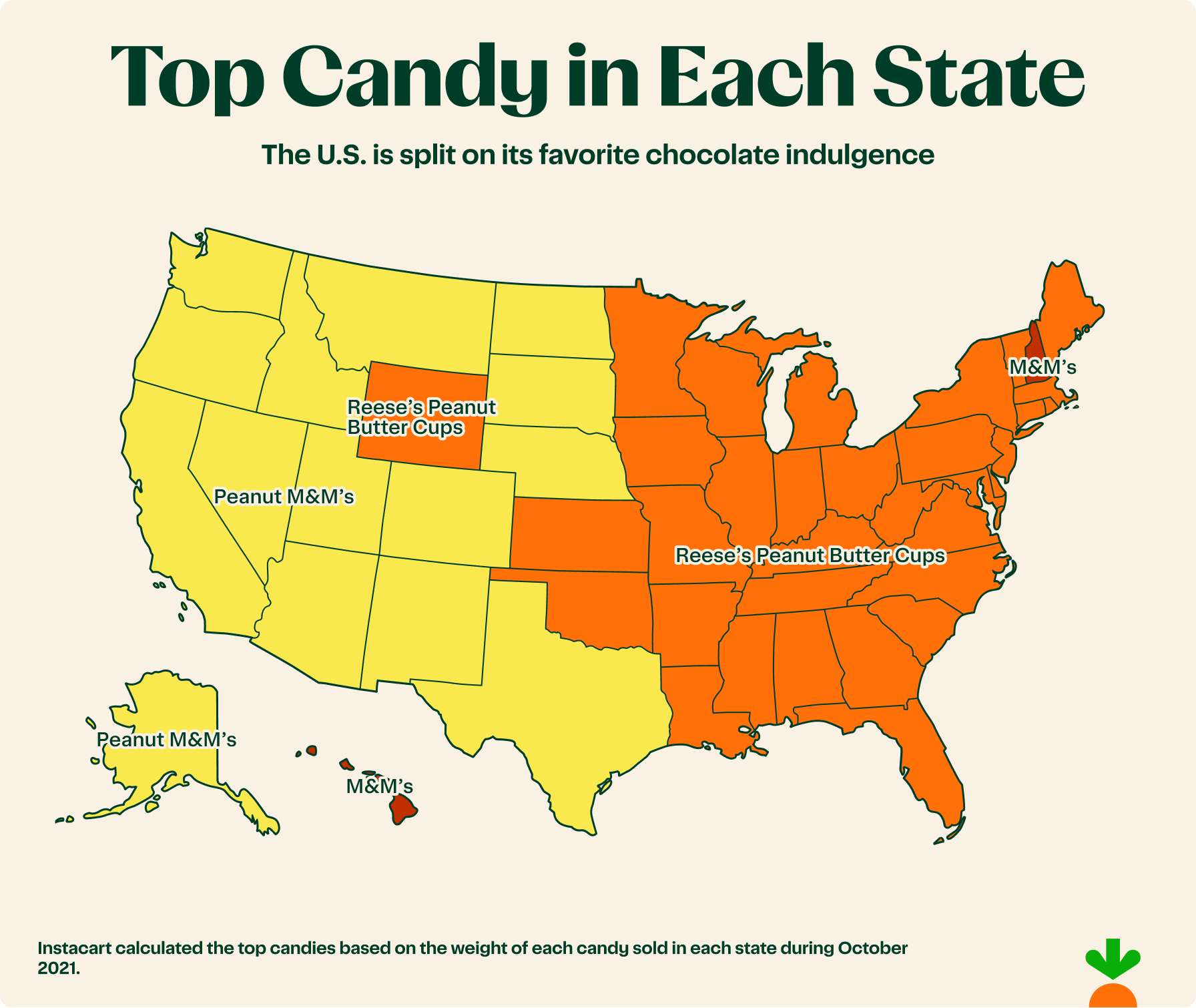
Beyond the top candy sold in each U.S. state, we uncovered similar candy rivalry patterns among Halloween staples across a number of candy categories, from chewy to hard to gummy and of course, more chocolate. Check out the drop-down menu below to discover the five ultimate candy contenders and what each state or region is more likely to buy. It may or may not scare you:
- Red Vines versus Twizzlers: While the two red, twisted rope candies are similar, there’s a cultural clash with the Pacific-Northwest and a bit of the West Coast preferring the chewy but easily breakable Red Vines that carry a subtle berry flavor, while the rest of the country prefers the more gelatinous Twizzlers known for a more pronounced strawberry zest.
- Dum Dums versus Charms Blow-Pops: Lollipop, lollipop, oh lolly, lolly, lolly — what’s a Halloween candy stash without suckers in the mix? While both of these are old-school favorites, the West Coast and sections of the Southeast and Northeast are partial to the smaller Dum Dums, while the Midwest and a bit of the South and North go for bubble-gum-filled Charms Blow Pops.
- Smarties versus SweeTarts: While both of these candies come in the form of sweet disks stacked on top of each other, there are distinctions. Smarties, which are a bit smaller, softer and more subtle in flavor, are the favorite on the East Coast, the Midwest, and the majority of the South, while the bigger and more tart SweeTarts are preferred in the Pacific Northwest, overseas in Hawaii and Alaska, and in Nevada, Colorado, New Mexico, and Mississippi.
- HARIBO versus Trolli Gummies: From gummy bears to gummy worms, both HARIBO and Trolli are arguably some of the most classic forms of gummy candy so it’s fair to say most have a favorite. The bulk of the West, the South, and a few states in the Northeast pick Trolli, and the Midwest and some surrounding states in the Southwest and Northeast would rather choose HARIBO.
- Whoppers versus Milk Duds: Although Whoppers are malted milk balls and Milk Duds are filled with chewy caramel, both of these traditional, milk chocolate-covered candies that roll out of a box are undoubtedly contenders. The majority of the South and a sprinkling of other states are the opposite of a dud — deeming Whoppers as their winner — whereas the West, Midwest, and Northeast opt for Milk Duds.
Between all of these candy preferences and everything beyond, who consumes the most Halloween candy across the board? Here are the states that buy the most and least amount of candy for Halloween according to Instacart purchase data.
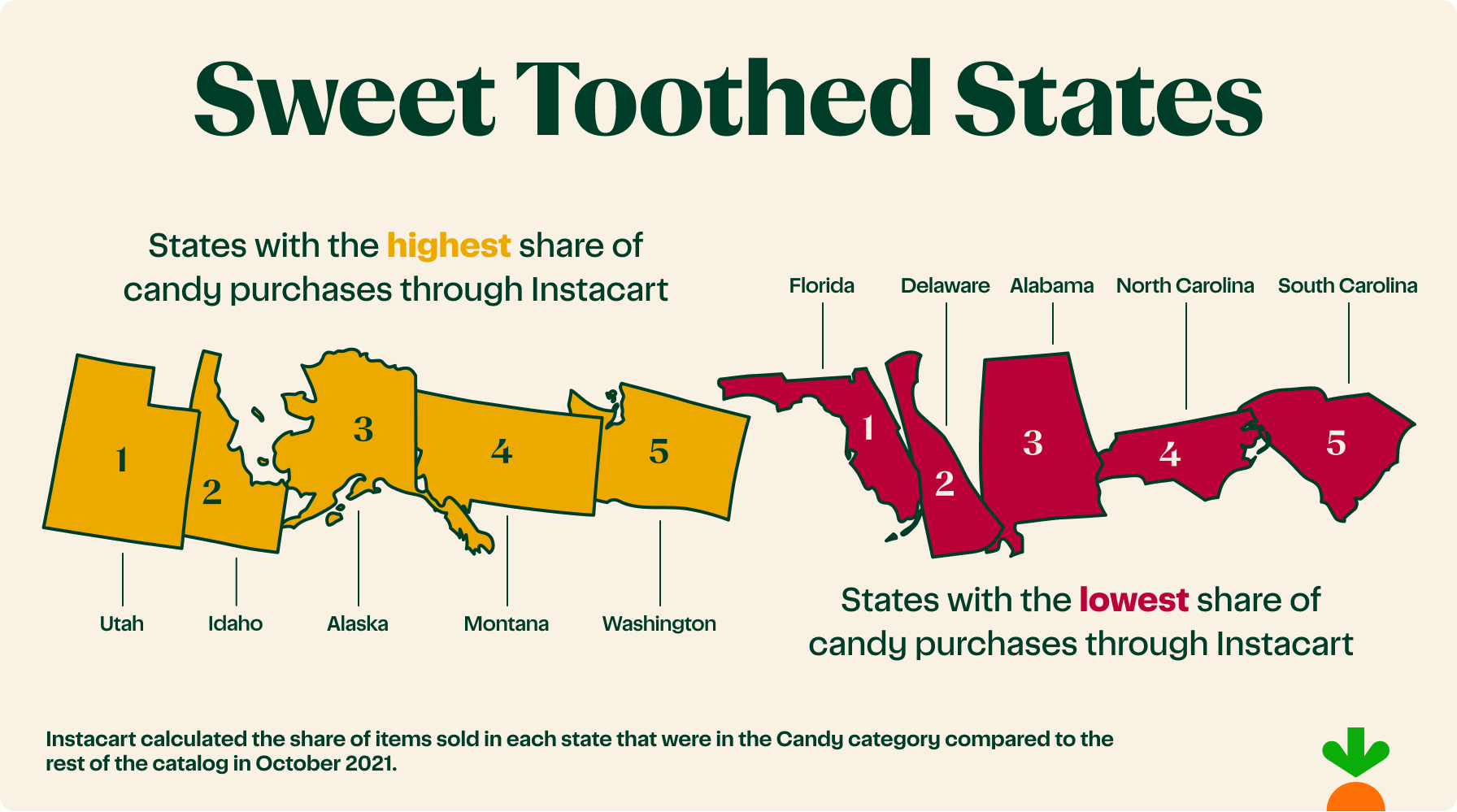
For two years in a row, Utah, Idaho, Alaska, Montana, and Washington purchased the most Halloween candy, demonstrating a bigger sweet tooth compared to Florida, Delaware, Alabama, North Carolina, and South Carolina all buy the least amount of Halloween candy.
Additional Sweet Insights 🍭
What else factors into the Halloween candy people select? Here are some not-so-confidential confectionery findings from our survey:
- To switch it up or not. We sought to learn if people buy the same types of candy every year and found that 23% of Americans are candy loyalists. Of those who are candy loyalists, 65% have been buying the same candy for 5 or more years, and 40% have been buying the same types of Halloween candy for 10 or more years. On the contrary, 25% of Americans say they always change the candy they buy, whereas 32% report going back and forth between a few of their favorite types of candy.
- Don’t be selfish. For those who plan to give out candy on Halloween, 27% say they are more likely to consider their own preferences over trick-or-treaters’ when buying candy, while 16% are more likely to consider trick-or-treaters’ preferences. However, 48% do say they consider both their own and trick-or-treaters’ preferences so each party has something to enjoy.
- It’s an acquired taste. Sixty-three percent of Americans report they now love a type of Halloween candy that they hated as a kid, and of those, 29% say they now love licorice, followed by 28% who developed an affinity for candy corn. On the other hand, 59% reported they now hate a type of Halloween candy that they loved as a kid, of whom 27% grew out of their candy corn phase and 21% now dislike chewing gum and sour candy.
- Post-Halloween stock-up. Sixty-two percent of Americans purchase candy on sale after the holiday because who doesn’t love a sweet deal?
- Leftovers that last. According to our survey, 88% of Americans who get a Halloween candy stash report having candy left over in their stash, and 86% of those will keep their Halloween candy stash for up to 6 months. New year, old candy? What’s more, the most popular type of Halloween candy — chocolate — is more likely to sit in a candy stash than all other types of candy. Are people savoring their favorite treat or can there be too much of a good thing?
Let’s Get This Party Startled! 👻
Of course, candy is only part of the Halloween equation — what about pumpkins, decorations, and costumes? While the widespread love for Halloween may give us the impression most people join in on the fun early, our data suggests most are getting ready closer to the holiday. Let’s take a look at when people are filling their carts with all of the components necessary for a festive celebration:
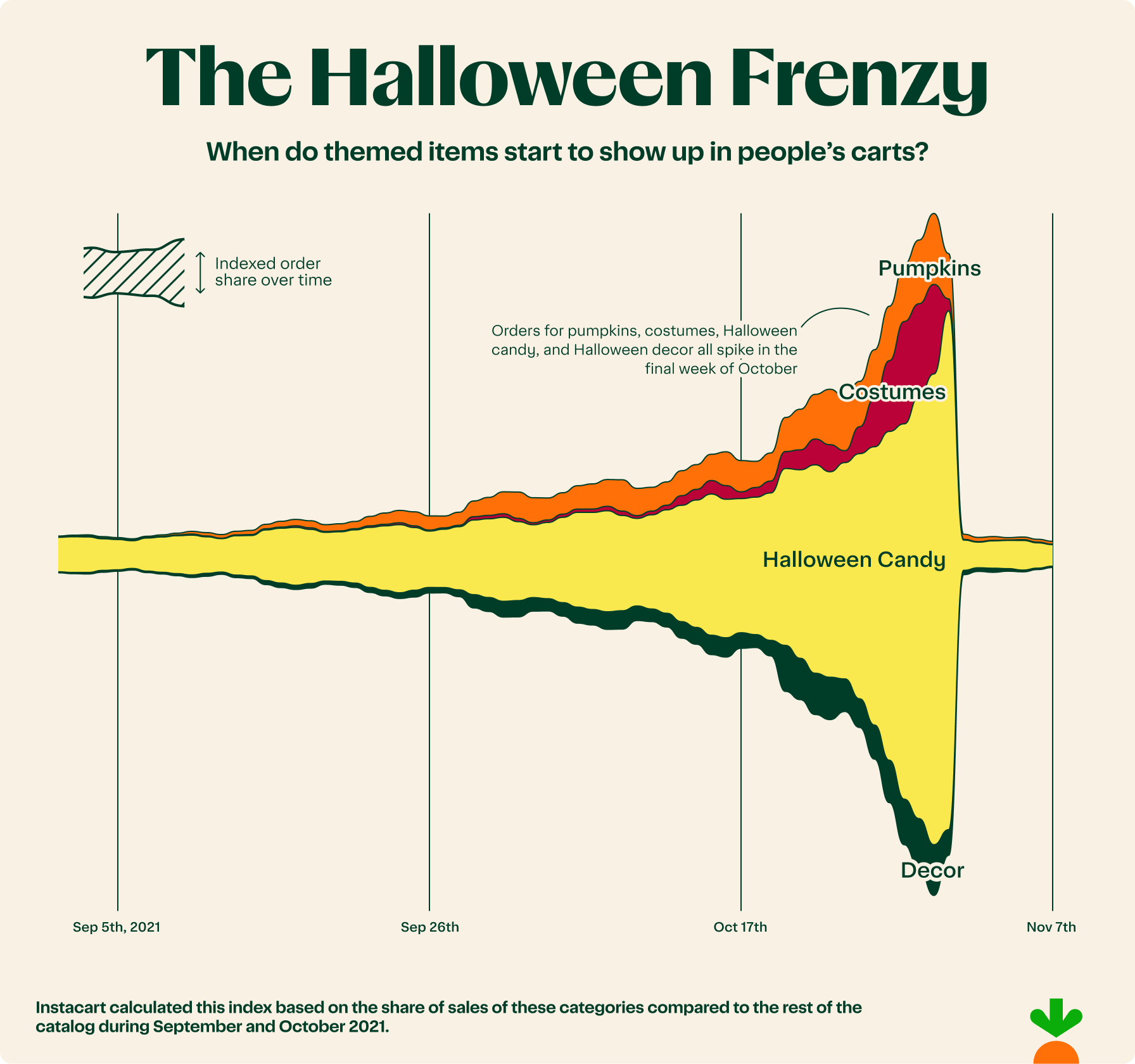
- Trick or treat yo’ self. Halloween candy purchases begin to ramp up halfway through September and spike exponentially in October with Halloween as the peak day for candy purchases.
- Go big or gourd home. Early birds start to purchase pumpkins at the end of September, and then the majority of people get their pumpkins during the last two weeks of October.
- Make it boo-tiful. From spider webs to skeletons, Halloween decor sees a slight increase in sales in September and then jumps during the first week of October followed by a more notable spike during the last two weeks of October before finally peaking on the day before Halloween.
- Dressing up is eerie-sistible. Halloween costumes don’t see very much sales activity until the second week of October, followed by an abrupt spike during the week leading up to Halloween and peaking just 3 days before the holiday.
Getting Into the Spirit! 🧛🏻♂️
So what exactly do people dress up as? While the options are endless, here are the top 5 costumes sold via Instacart in 2021:
- Peanut Butter and Jelly Couples Costume. Because what two things go better together?
- Hippie Costume Kit. Peace and love — we dig it.
- Alien Pick Me Up Inflatable Costume. Getting abducted by an alien is not out of this world.
- Banana Costume. It’s a bit cliche, but whatever makes you peel good.
- Lab Coat Doctor Costume. Living the scrub life for a night.
Whether or not you plan to pick an ensemble to dress up in, indulge in candy, decorate your house, carve and light up pumpkins, or do all of the above, we hope you have a Happy Halloween and enjoy the darkest night. 🧟♀️
Survey Method:
This survey was conducted online within the United States by The Harris Poll on behalf of Instacart from September 13-15, 2022, among 2,076 adults ages 18+. The sampling precision of Harris online polls is measured by using a Bayesian credible interval. For this study, the sample data is accurate to within +/- 2.8 percentage points using a 95% confidence level. For complete survey methodology, including weighting variables and subgroup sample sizes, please contact [email protected].
Adjusted for Growth:
We adjust Instacart growth percentages by the overall growth of total deliveries. Doing so removes the influence of our platform growth so we can focus on the change in consumer behavior.
Most Recent in Company Updates

Company Updates
One Million Products Discovered and Delivered Through Free Gift Campaigns on Instacart
Connecting consumers with their new favorite brands with free product sampling We've hit an exciting milestone: over one million products delivered to consumers through our free gift advertising offering, designed to help people discover brands…
Feb 20, 2025
Company Updates
Classroom Carts: Supporting LA Schools Impacted by Wildfires
The recent wildfires in Los Angeles have had a devastating impact on the community – displacing families, closing schools, and forcing students and teachers to rely on remote learning. In the midst of the crisis…
Feb 19, 2025
Company Updates
Tackling Food Deserts in Columbia, SC: First Year Success and Program Expansion Plans
Many people across the country continue to face challenges accessing food because they live in food deserts – areas where affordable food options, including fresh fruits and vegetables, are hard to find. But we have…
Feb 3, 2025

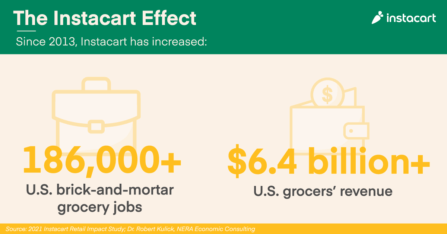 Instacart’s Impact on America’s Grocery Industry, by the Numbers
Instacart’s Impact on America’s Grocery Industry, by the Numbers 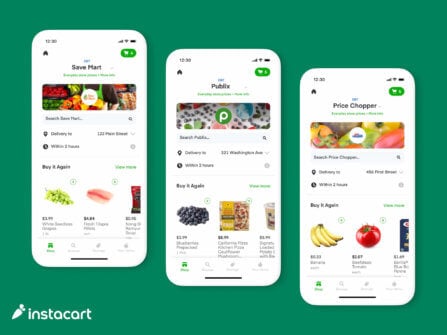 Breaking Down Barriers to Food Access with EBT SNAP Expansion
Breaking Down Barriers to Food Access with EBT SNAP Expansion  Beyond the Cart: A Year of Essential Stories
Beyond the Cart: A Year of Essential Stories 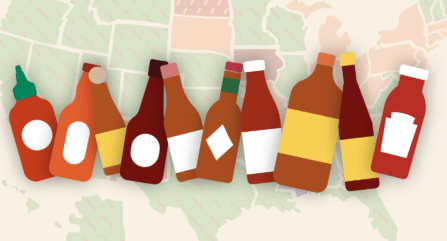 A Hot Take on America’s Favorite Hot Sauces 🌶
A Hot Take on America’s Favorite Hot Sauces 🌶 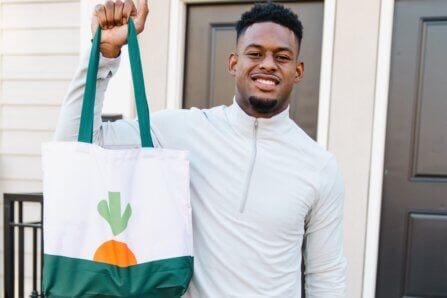 JuJu Smith-Schuster: What’s in my Cart?
JuJu Smith-Schuster: What’s in my Cart?  Introducing the First-Ever Instacart Emerging Brand List
Introducing the First-Ever Instacart Emerging Brand List 
